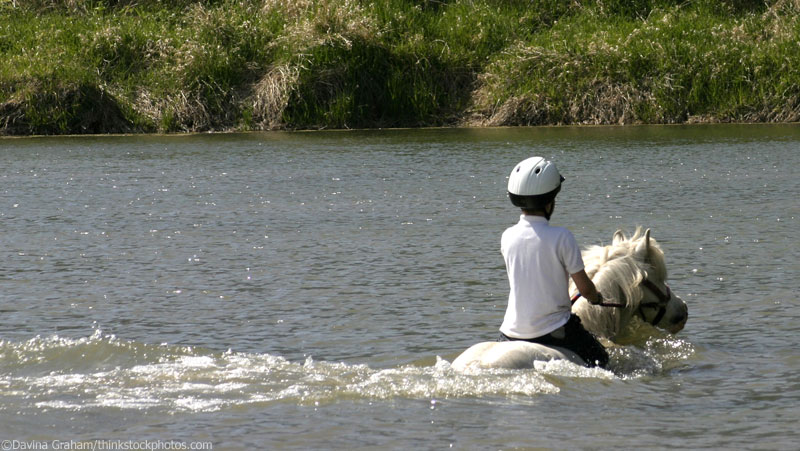What better way to beat the heat than riding your horse into a refreshing oasis? Be it the ocean, a lake, or even the local creek, here are some tips to remain safe while on horseback in the water.

- Know the area. This is perhaps the single most important factor in equine water safety. What you don’t know can hurt you and your horse. For ocean rides, be aware of tides and local currents. Be familiar with the beach and its footing—are there areas of sudden drop offs? How deep is the sand?
Be aware that footing can be deceiving. Mud along the edge of a river or lake can be deep and horses have been known to panic when stepping through thick mud. Lakes and rivers can have hidden debris such as rocks or even large pieces of dangerous junk like old cars. Resist the urge to explore murky unknown bodies of water.
- Know your horse’s ability. If this is your horse’s first trip to the beach, let him get used to the scene before getting him into water that requires swimming. Even if your horse is reasonably fit, churning through water with a rider is extremely demanding, so be mindful of your horse’s exertion. If swimming in deep water, let your horse have his head—there’s no need to hold a proper head carriage when swimming! If you’re visiting the ocean during hot weather, also remember to keep your horse’s hydration in mind since he can’t drink the salt water.
- Don’t take risks. The old adage of trusting your gut is a good one to remember in the water. If you’re not sure how strong the current is or you think a river may be a little too deep and too fast to cross, don’t try it.
- Use the buddy system. Always ride in the water with someone else and make sure someone at the barn or at home knows where you are and has an idea of your expected return.
- Know your equipment. Don’t ride into water with your horse wearing a tie-down or martingale. While it may be a good idea in some cases to have your horse wear a halter and have a lead in case you have to lead him, make sure all leads and reins are not long enough to provide a possibility of getting legs tangled when in the water. If you drive your horse, never take a cart into unknown water; the weight of a cart can be enough to drown a horse if the water is deep or the current strong.
- Know how to swim. This seems simple, but can easily be overlooked. Do not ride into deep water if you can’t swim and enforce this rule for everyone in your riding group. If you have to come off your horse in deep water, stay well away from churning hooves. If you come off your horse in the water, the safest place is to the side—do not get directly in front of a swimming horse.
- Watch out for a roll. This may be one of the oldest horse tricks in the book: riding into a shallow stream, your horse begins to paw at the water and before you know it, down he goes for a good, refreshing roll without a thought about you still on his back! To prevent inadvertent soaking, don’t let your horse paw at the water.
Liked this article? Here are more on riding in the water.
Conquer Water Crossing
Pat Parelli: Crossing Water with Confidence
Video: Beach Ride
Anna O’Brien, DVM, is a large animal veterinarian in Maryland and a regular contributor to Horse Illustrated magazine and horseillustrated.com. Follow Dr. O’Brien on Twitter: @annaobriendvm.






all great tips and I wish had a place to go with my girl to cool off with her. Looks like fun
And watch out for flailing horse limbs!
cool
My three horses and two donkeys all LOVE to go to the beach in the summer. They will happily just stand in the cool water and soak their feet for long periods of time. It’s such fun for me, too.
Actually, my Welsh Pony mare Magie likes to paw at the water a lot. People try to tell me that she is going to roll but after having her for over 6 yrs, she has never tried to roll in water. I think she just loves to splash and every time makes me almost fall off her back from the belly laughs she gives me. Other than trying to go too far in our pond, and then potting her nose underwater (scary) she is amazing in the water.
Love the comment about never using a tie-down. Years back at a local state recreational area a couple went riding. They stopped at the edge of an island – like peninsula (complete w picnic tables & rest area facilities so not deserted). Horses were allowed a drink. Mucky edge. Horses went into man-made lake (with riders ). Spouse & horse drowned. I shudder every time I visit the location. These were experienced riders & adults who were not 100% aware of the drop off area & the danger of using the tie-down that prevented the horse from lifting it’s head to get air.
I noticed in your breed horses that the Boulonnais, marble horse of France is not listed. I’ve imported a Boulonnais 4 year old Stallion. I’m very excited about him. We also imported a bred 3 year old.
This is a rare large draft horse that’s elegant and refined yet very sturdy. This breed dates back to 57 BC, with a breed type set in the 17 Century at which this breed type still is the norm.
This breed has not walked in the United States for over 115 years. They were once a horse that was prized and their numbers were as high as 600000 before WW 1, after WW 2 they were decimated, have since numbered between 750 horses to around 1000.
With so few of these horses out their I do think your readers would like to know about and see photos of them.